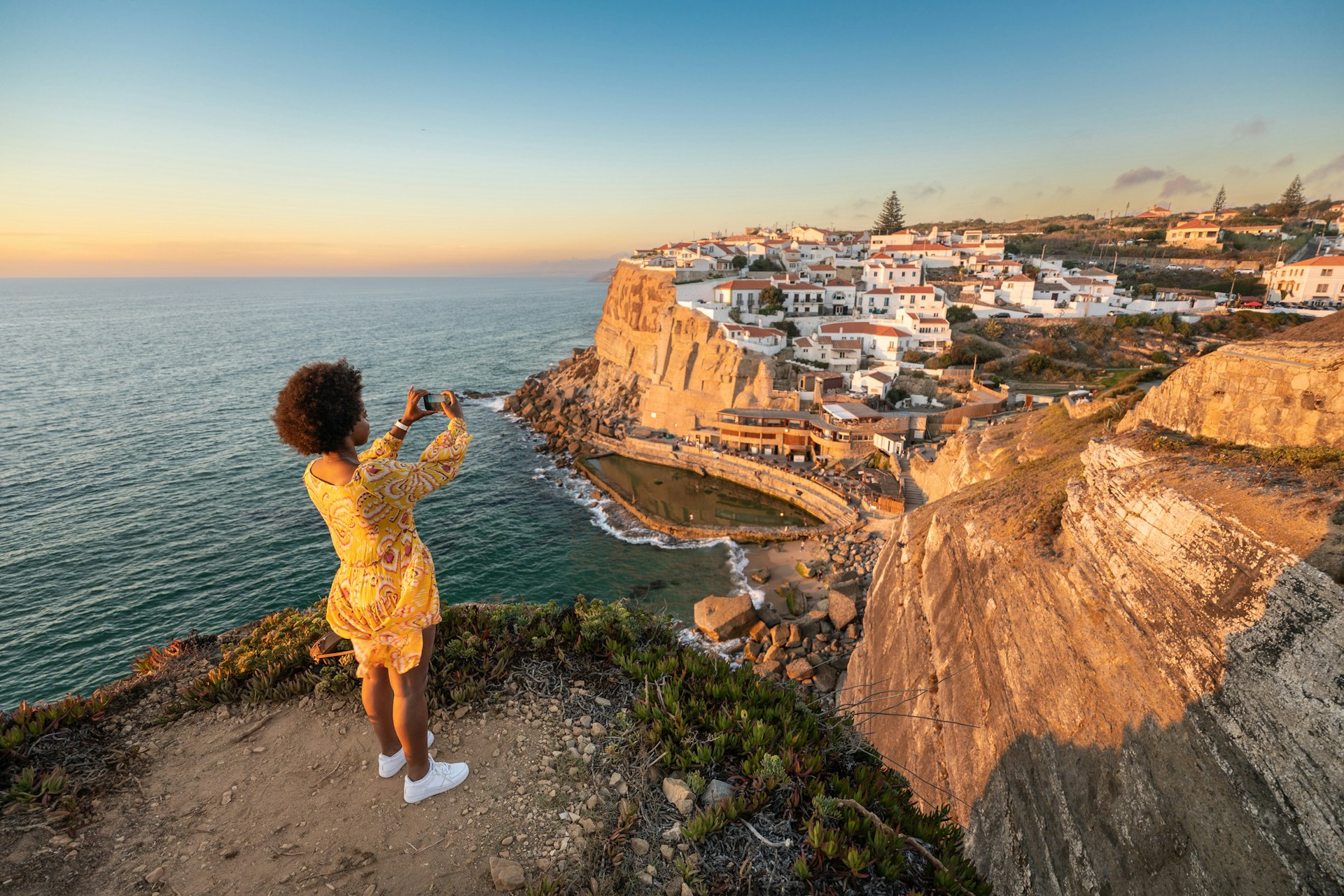When you’d like a break from meandering the hilly, cobblestoned streets of Lisbon, head to one of these six destinations for a great day trip.
From surfing trips and romantic hill towns to emerging art spots and heritage sites, explore beyond the Portuguese capital with any of these amazing day trips, less than two hours away.
1. Sintra
Travel time: 40 minutes
Mystic and romantic, Sintra is one of the most popular day trips from Lisbon. With several UNESCO sites, the small town is folded into lush mountains, surrounded by ostentatious palaces, and is home to an estate with a history of esotericism and secret rituals.
Take the bus or brave the uphill climb to visit two of Sintra’s best-known landmarks: medieval castle Castelo dos Mouros and 19th-century Palácio Nacional da Pena. Castle visits usually last 60 to 90 minutes, and then you can walk down the main road that leads to the historic center, snaking through the virtually untouched slopes of Serra de Sintra. Split your time between exploring the heart of the picturesque city on foot, visiting the Palácio Nacional de Sintra, and exploring Quinta da Regaleira and its Initiation Well, the root cause of legends and myths surrounding the estate.
Regardless of where you go for lunch, no trip to Sintra is complete without a stop for the typical pastries. Since 1862, Casa Piriquita has baked the famous travesseiros (a light puff pastry with an egg and almond filling, shaped like a pillow) and the bite-size tarts known as queijadas de Sintra.
How to get to Sintra from Lisbon: Take the suburban train (Sintra Line) from Rossio. If you prefer to drive, the shortest route is on A37, but you should bear in mind only residents’ cars, buses and taxis are allowed in the historic center. Sintra is 40 minutes from Lisbon by train and 30 minutes away by car. Trains depart every 15 to 20 minutes on weekdays and every half-hour on weekends.
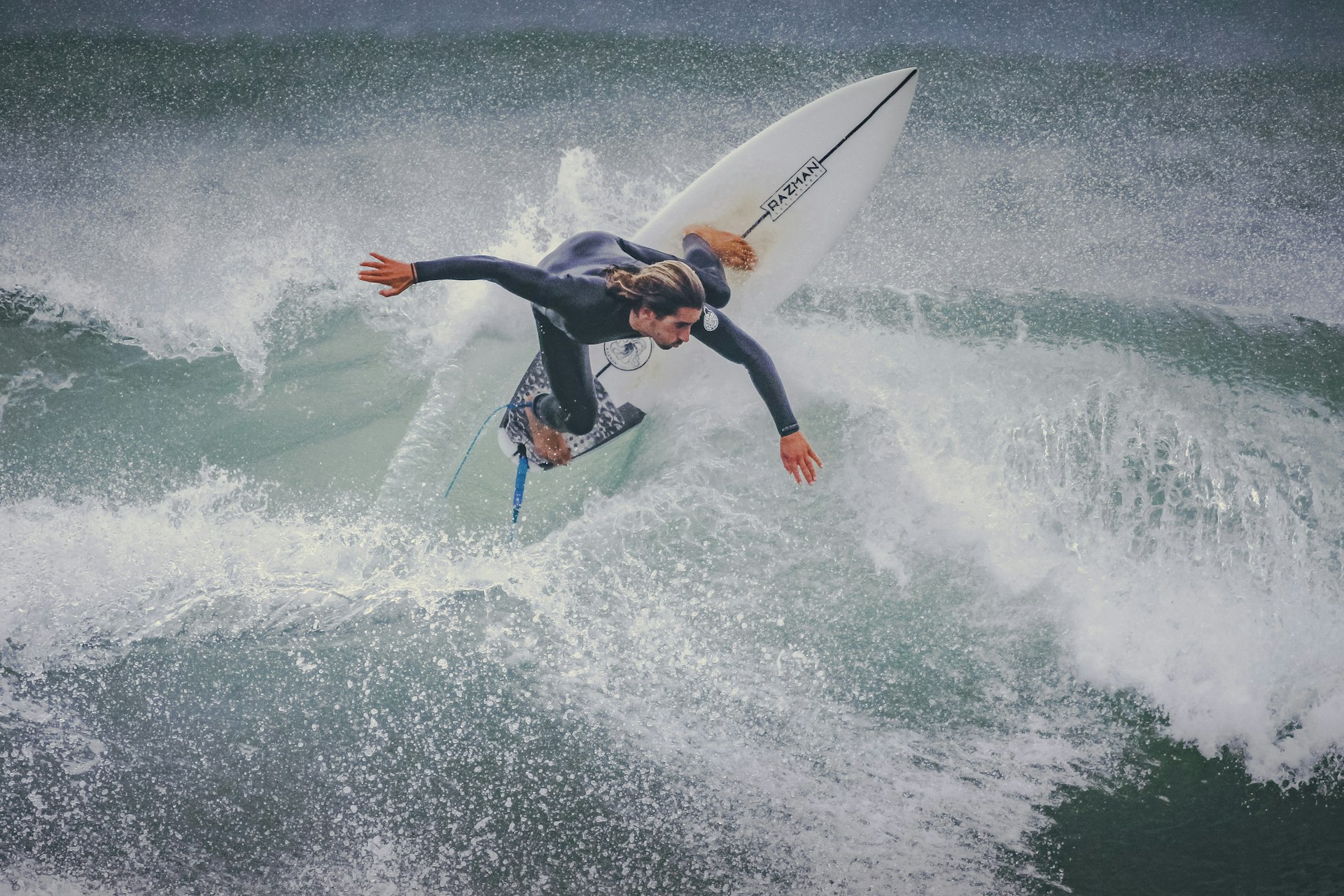
2. Peniche
Travel time: 1 hour 30 minutes
Surfers headed north to Peniche long before the giant waves of neighboring Nazaré put Portugal‘s Atlantic Coast on the surfing map. This small city with a rugged shore is a great beach destination during the summer and a surfing hot spot all year long. Whether you’re after surf breaks or not, the beaches are one of Peniche’s main attractions, where Baleal and Supertubos are the best-known breaks amongst those who love to ride the waves.
The city’s historic center is easy to explore on foot, with the Atlantic Ocean in the background. In the summer, take the 45-minute boat trip to Berlenga Grande island to roam its beaches and nature reserve. Visit the fortress, a former political prison during the Conservative Dictatorship (1930 to 1974), which has been turned into a museum dedicated to the anti-regime resistance.
In a seaside city where fishing is still one of the main economic activities, seafood dishes abound. Whether you’re looking to try caldeirada (fish stew) or want to stick to grilled sardines, restaurants with catch-of-the-day on the menu are easy to find. Just search for a marisqueira (seafood restaurant) near the shore.
How to get to Peniche from Lisbon: Travelers can catch buses from Lisbon’s Sete Rios bus station, and tickets are available with Rede Expressos. For those who want to drive, Peniche is 100km (62 miles) north of Lisbon. It’s about 1¼ hours away via the A8 and 1½ hours via the A1.

3. Évora
Travel time: 1 hour 30 minutes
Known as the capital of the Alentejo region, Évora’s distinctive whitewashed houses with yellow baseboards fit the typical image of the center-south. Ideal as a short road trip from Lisbon, sunny Évora offers great food, wine and historical Roman sites.
Évora’s Roman temple is every visitor’s first stop. The 1st-century marble building is well-preserved, despite its age, and is one of Portugal’s most significant relics of the Roman Empire. Gruesomeness aside, the 17th-century Bone Chapel is also a must-visit in Évora. Part of São Francisco church, it was decorated top to bottom with bones and skulls to remind Catholic churchgoers that life is fleeting. Afterwards, head to Praça do Giraldo for a well-deserved breath of fresh air.
Alentejo cuisine is typically rich in flavor but with humble origins. Go to Café Alentejo for petiscos (finger food and snacks) like scrambled eggs with farinheira (a flour-based sausage) or Taberna Típica Quarta-Feira for typical dishes like fried pork. If you’re in Évora mainly for the wines, head to Cafetaria Páteo de São Miguel for Cartuxa wine by the glass, or to Ervideira Wine Shop for a wine tasting, with or without a food pairing.
How to get to Évora from Lisbon: Buses depart from both Oriente and Sete Rios stations and can be found on the Rede Expressos website. If you want to drive, it’s 135km (84 miles) south of Lisbon. Take the A2 to cross the Ponte 25 de Abril bridge and then continue along the A6 on the south bank. If you’re driving to Évora from the east side of the city, take the A12 to cross the Vasco da Gama bridge and then continue along the A6. It’s about a 1½ hour drive either way. Parking inside the city walls is limited to residents, hotel guests and people with reduced mobility. Outside the walls, the parking lot closest to the historic center (10 minutes’ walk) is near Porta Velha da Lagoa.
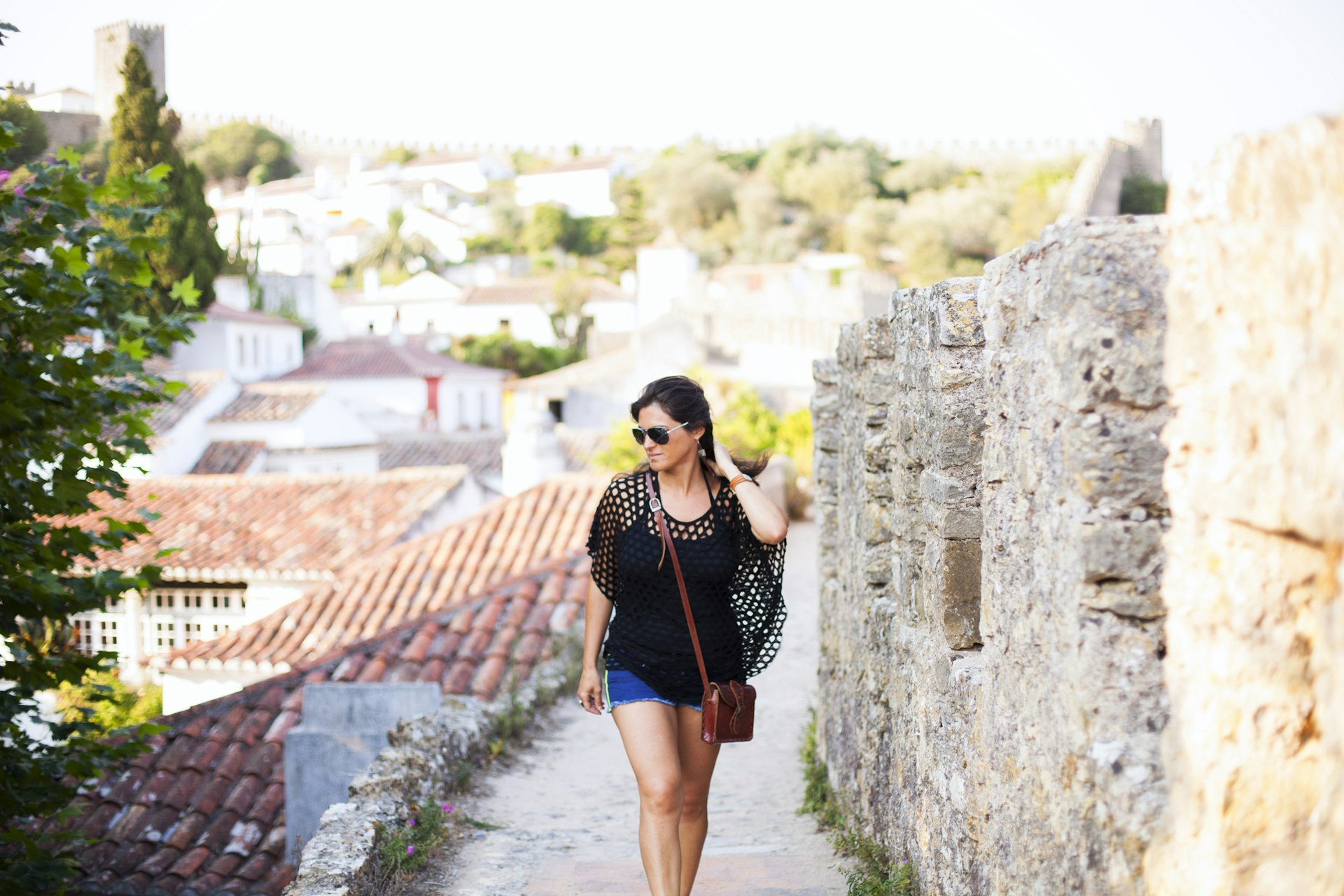
4. Óbidos
Travel time: 1 hour 15 minutes
While the walled city of Óbidos may draw in crowds of travelers, it’s not hard to see why this tourist town enchants so many people. It boasts cobbled streets flanked by whitewashed homes, and its core is surrounded by medieval walls that visitors can walk along (if they dare). Follow these walls for amazing views of the town below and up to the Castelo de Óbidos, a 13th-century structure that is now a hotel called the Pousada do Castelo. Rua Direita – the town’s main road – is lined with chocolate and sour cherry-liqueur (ginjinha) shops to entice its many visitors, but make time for a rewarding wander deeper into the winding streets, too.
However, the real draw of Óbidos may be for bibliophiles. This historic town is a UNESCO City of Literature and punches far above its weight in its number of amazing bookstores. Step into Livraria de Santiago, a bookshop within the 18th-century São Tiago church, which was originally built in 1186 and ‘rebuilt in 1772 after it was destroyed by the 1755 Lisbon earthquake.
While Óbidos is a popular day trip, visitors may be tempted to stay the night at The Literary Man. This book-lined hotel also boasts the Literary Gin Bar, where even casual visitors can sip cocktails with suitably bookish names.
How to get to Óbidos from Lisbon: Óbidos is about 1¼ hours away from Lisbon via the A8. Take exit 15 and follow the signs to Óbidos. Travelers can take this same expressway to continue west to Peniche. For those who want to take public transit, there is a bus that departs from the Campo Grande bus station, operated by Rodoviária do Oeste. Departure schedules can be found online, but tickets are purchased on the bus.
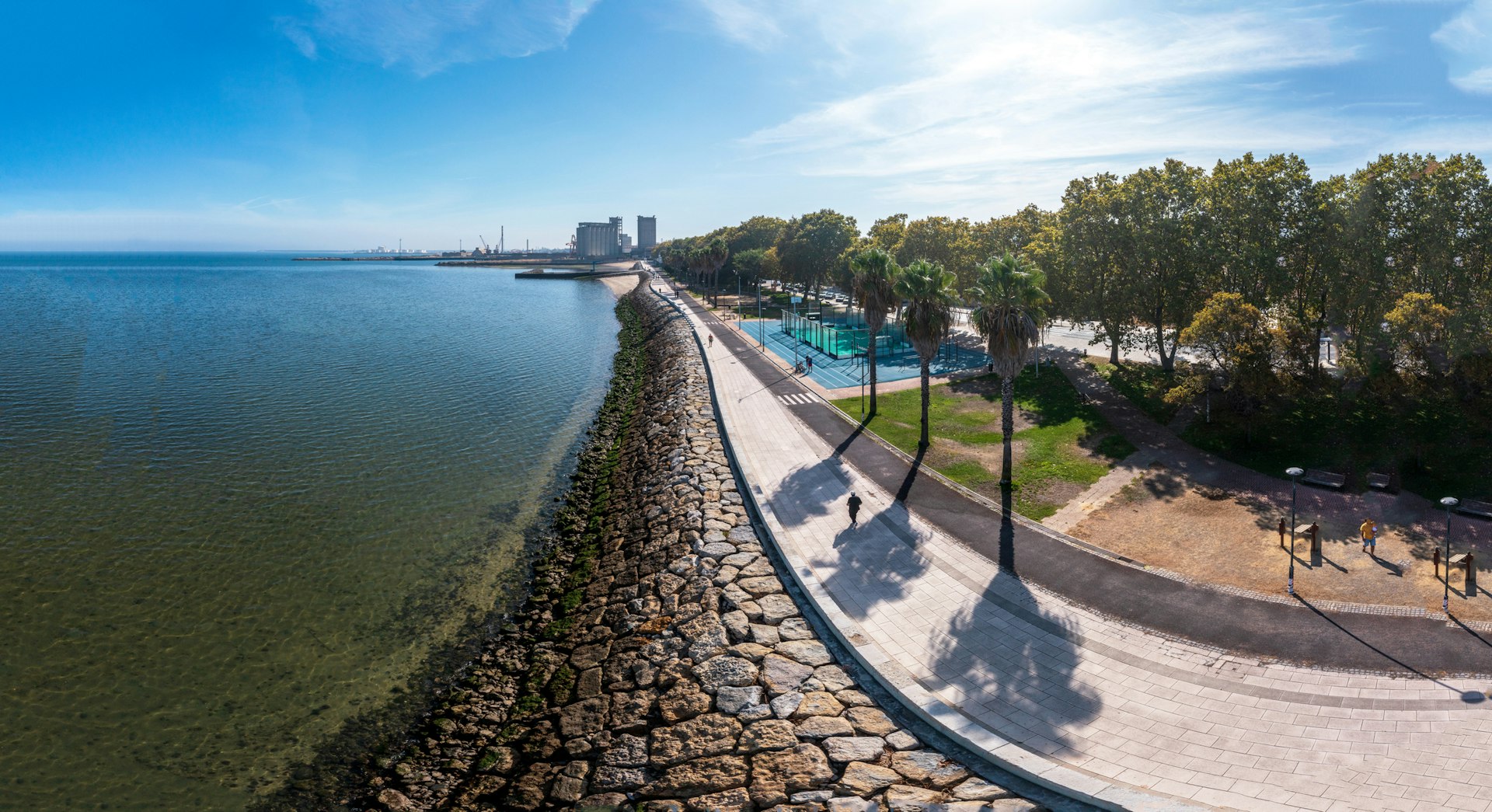
5. Barreiro
Travel time: 25 minutes
A formerly industrial city on the south bank of the Tagus River, Barreiro is slowly coming out of the smoky shadows of its factory-heavy past and is now one of the best art spots in the country. The best of the river towns, Barreiro is an up-and-coming day trip destination whose main attractions and tours pay tribute to its industrial heritage. The well-known street artist Vhils has also moved his workshop to Baía do Tejo, a former factory-turned-business hub.
As you come out of the ferry, walk to the left until you reach the old train station. Beyond the building, you’ll notice the white-sand beach, Alburrica, famous for its windmills and occasional river surfers. Riding waves on the river, with the help of ferries during rush hour, is a trend that was started by the local sports organization Gasoline. Look for street art alongside Av Bento Gonçalves, where the back wall of the creative center Escola Conde Ferreira has the most eye-catching mural. Book a tour with a local company to learn more about Barreiro’s industrial heritage or the story behind Vhils’ largest piece yet at Baía do Tejo. On your way back to the ferry station, have a peek at ADAO, a local arts and culture organization that refurbished the former firefighters’ headquarters.
Barreiro’s local food is heavily influenced by the Algarve and Alentejo roots of former factory workers. Most restaurants alongside ‘Beach Avenue’ (officially Av Bento Gonçalves) serve typical Portuguese food, and fish dishes prevail. For a lighter meal, head to àPortuguesa Brr; with occasional live music, this cafe-bar serves only Portuguese products.
How to get to Barreiro from Lisbon: Take the ferry boat from Terreiro do Paço. A one-way ticket costs around €2.65. Ferries depart every 30 to 60 minutes on weekends and every 10 to 20 minutes on weekdays. It will take 20 to 25 minutes by ferry.
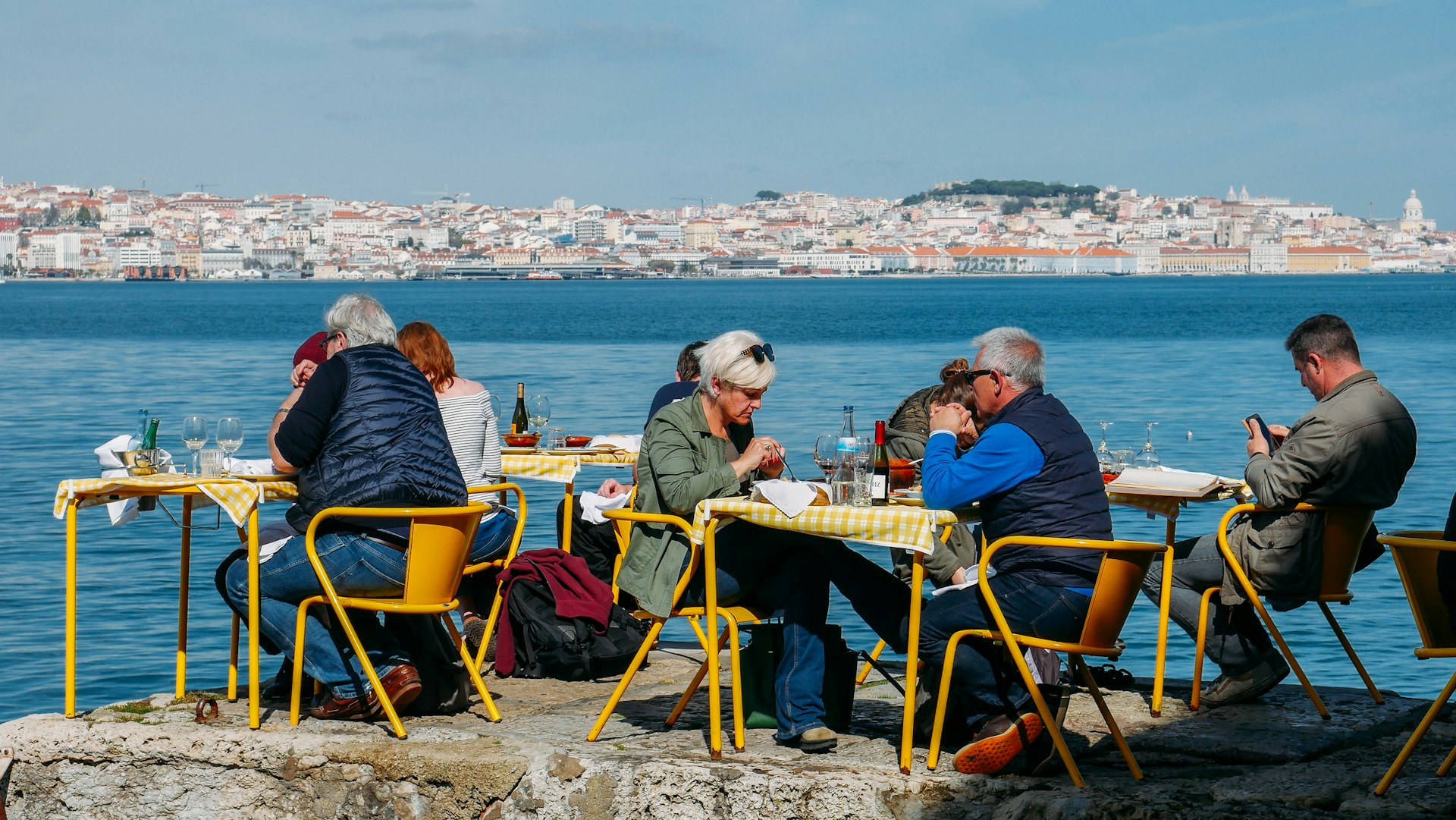
6. Cacilhas
Travel time: 10 minutes
While most people travel through Cacilhas en route to the Cristo Rei viewpoint, this colorful riverside borough of Almada is worth more than a pit stop. Follow the calling of freshly grilled fish at riverside restaurants and stay for the picturesque small-town houses to observe local amateur fishers, and discover a thriving cultural scene.
Stroll alongside the Tagus River on the street right of the ferry boat station and soak in the view of Lisbon on the north bank. Take the free panoramic lift to see the city from another angle or simply to skip the climb uphill. Head to the cultural center, Casa da Cerca, a five-minute walk from the lift, for contemporary art exhibitions or coffee with a view from its outside terrace (weather permitting). Walk down to your starting point, passing by Rua Cândido dos Reis, Cacilhas’ famous street full of bars, shops, cafes and restaurants (where fish dishes prevail). Pop inside book shops like Meia Volta de Urano to browse old art and for a chance to catch an impromptu jam session.
Traditional restaurants closer to the ferry boat station, like the famous Ponto Final, serve mainly fresh seafood. At Rua Cândido dos Reis, you’ll find a greater variety of restaurants, from pizzas and artisanal hamburger joints to ice cream shops and spots serving typical Portuguese cuisine.
How to get to Cacilhas from Lisbon: Take the ferry boat from Cais do Sodré. A one-way ticket costs around €1.30, and it takes 10 minutes. Ferries depart every 10 to 20 minutes, depending on the time of the day and day of the week.
